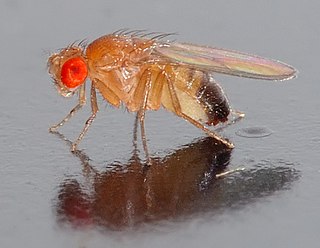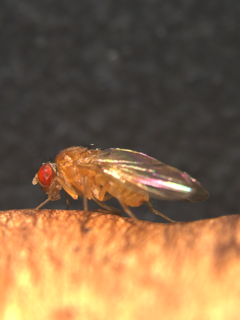
Drosophila is a genus of flies, belonging to the family Drosophilidae, whose members are often called "small fruit flies" or pomace flies, vinegar flies, or wine flies, a reference to the characteristic of many species to linger around overripe or rotting fruit. They should not be confused with the Tephritidae, a related family, which are also called fruit flies ; tephritids feed primarily on unripe or ripe fruit, with many species being regarded as destructive agricultural pests, especially the Mediterranean fruit fly.

Allopatric speciation – also referred to as geographic speciation, vicariant speciation, or its earlier name the dumbbell model – is a mode of speciation that occurs when biological populations become geographically isolated from each other to an extent that prevents or interferes with gene flow.

Ribosomal DNA (rDNA) is a DNA sequence that codes for ribosomal RNA. These sequences regulate transcription initiation and amplification, and contain both transcribed and non-transcribed spacer segments.

The Drosophilidae are a diverse, cosmopolitan family of flies, which includes species called fruit flies, although they are more accurately referred to as vinegar or pomace flies. Another distantly related family of flies, Tephritidae, are true fruit flies because they are frugivorous, and include apple maggot flies and many pests. The best known species of the Drosophilidae is Drosophila melanogaster, within the genus Drosophila, also called the "fruit fly." Drosophila melanogaster is used extensively for studies concerning genetics, development, physiology, ecology and behaviour. Many fundamental biological mechanisms were discovered first in D. melanogaster. The fruit fly is mostly composed of post-mitotic cells, has a very short lifespan, and shows gradual aging. As in other species, temperature influences the life history of the animal. Several genes have been identified that can be manipulated to extend the lifespan of these insects. Additionally, Drosophila subobscura, also within the genus Drosophila, has been reputed as a model organism for evolutionary-biological studies, along with D. sechellia for the evolution of host specialization on the toxic noni fruit and Scaptomyza flava for the evolution of herbivory and specialist on toxic mustard leaves.

The Drosophilinae are the largest subfamily in the Drosophilidae. The other subfamily is the Steganinae.

The paraphyletic subgenus Sophophora of the genus Drosophila was first described by Alfred Sturtevant in 1939. It contains the best-known drosophilid species, Drosophila melanogaster. Sophophora translates as carrier (phora) of wisdom (sophos). The subgenus is paraphyletic because the genus Lordiphosa and the species Hirtodrosophila duncani are also placed within this subgenus.
The Drosophila polychaeta species group is a species group of fruit flies in the subgenus Drosophila.
The Drosophila saltans species group contains 21 described fly species, all of which are found in the neotropical region. It is one of the seven species groups in the subgenus Sophophora, the others being the D. willistoni, D. melanogaster, D. obscura, D. dispar, D. fima, and D. dentissima groups. The D. saltans species group is most closely related to the D. willistoni subgroup. The species are placed into five subgroups: the D. s. cordata, D. s. elliptica, D. s. parasaltans, D. s. saltans, and D. s. sturtevanti subgroups. It is thought that, like the D. willistoni species group, the D. saltans species group originated in tropical North America, colonized South America, and then diversified prior to the formation of the Isthmus of Panama. Some of these may have migrated back to North America within the last 4.5 million years ago (mya), and consequently the relationship between the species is unresolved due to the short amount of time that has elapsed since their divergence points.
Drosophila quinaria is a species of fruit fly in the Drosophila quinaria species group. Most Quinaria group species feed largely on mushrooms. However D. quinaria instead eats decaying vegetative matter, a trait it evolved independently.

The Drosophila testacea species group belongs to the Immigrans-tripunctata radiation of the subgenus Drosophila, and contains 4 species: Drosophila putrida, Drosophila neotestacea, Drosophila testacea, and Drosophila orientacea. Testacea species are specialist mushroom-feeding flies, and can metabolize toxic compounds in Amanita mushrooms. The Testacea species group is studied for its specialist ecology, population genetics, and bacterial endosymbionts. The North American species Drosophila neotestacea is perhaps the best-studied of the group for its interactions with parasitic wasps and nematodes, bacterial endosymbionts, and trypanosomatid parasites. Of note, selfish X chromosomes have been discovered in three of the four Testacea group species.
Drosophila bizonata is a species of fruit fly in the Drosophila bizonata species group in the Immigrans-tripunctata radiation of the Drosophila subgenus. Drosophila bizonata is found in Japan. D. bizonata breeds and feeds exclusively on mushrooms, and has a high tolerance for ibotenic acid, a toxic compound found in Amanita mushrooms.

The Drosophila quinaria species group is a speciose lineage of mushroom-feeding flies studied for their specialist ecology, their parasites, population genetics, and the evolution of immune systems. Quinaria species are part of the Drosophila subgenus.
The Drosophila cardini species group belongs to the subgenus Drosophila of vinegar flies in the Immigrans-tripunctata radiation of the subgenus Drosophila. The closest relatives of Cardini species include Drosophila bizonata, Drosophila quinaria, and Drosophila testacea species groups, comprising mushroom-feeding flies. Cardini group species likely derived their more general feeding ecology from a mushroom-feeding ancestor, an evolutionary transition in feeding similar to Drosophila quinaria.
The Drosophila tripunctata species group is a species group of fruit flies in the subgenus Drosophila.

The Hawaiian Drosophila are a monophyletic and speciose lineage of Drosophila vinegar flies, and members of the subgenus Drosophila. Over 1000 species of Drosophila are endemic to the Hawaiian Islands. The Hawaiian Drosophila species also include the "picture-wing" clade of Drosophila, named for the intricate patterns of melanin pigment on their wings. Over 100 species belong to the picture-wing clade of flies, prompting the generation of a database devoted solely to wing diversity in the Hawaiian Drosophila lineage. The Hawaiian Drosophila species group is presently paraphyletic, as the putative Scaptomyza genus is nested within the Hawaiian Drosophila clade.
The Drosophila angor species group is a species group of fruit flies in the subgenus Drosophila.
The Drosophila melanica species group is a species group of fruit flies in the subgenus Drosophila.
The Drosophila quadrisetata species group is a species group of fruit flies in the subgenus Drosophila.
The Drosophila repleta species group is a species group of fruit flies in the subgenus Drosophila.
The Drosophila virilis species group is a species group of fruit flies in the subgenus Drosophila.








